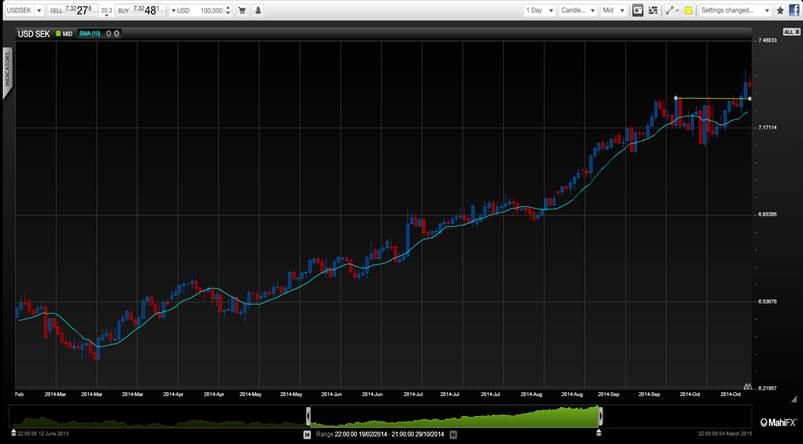The bogeyman of the markets used to be the banks, then it was recession (still an issue to an extent) and now it is deflation. Deflation fears seem to be exerting greater influence on forex markets due to the growing preoccupation with falling prices by central bankers.
Interestingly, the Riksbank went further than markets expected with its rate cut, despite Sweden's decent economic prospects. The economy is on course to grow 1.9% this year, compared with 1.7% last year and could notch up 2.7% in 2015.
But the move was less about sustaining growth, though the stagnating Eurozone is a concern for the Riksbank. It was primarily about the prospect of deflation taking hold in Sweden. It's a line of thinking, which is not only influencing policy at the Bank of Japan and the European Central Bank, but increasingly the Fed and the BoE.
The deflationary trade – SEK this week's loser?

Profound implications for USD and GBP
Sweden's move suggests that both the Fed and the BoE could delay interest rate rises indefinitely and may even return to more quantitative easing at some point – even with decent economic growth and job creation taking place. This would have profound implications for GBP and USD versus other currencies, potentially sending them lower.Yet the US and UK economies have relatively good economic outlooks for 2015 with the US and its huge domestic economy being well placed to withstand slowdowns in China, Japan and the Eurozone. Both also have relatively strong financial systems. At the moment at least, there appears to be no imminent major crisis – just continued uncertainty, which seems to be the norm now.
However, the recent bout of deflation is actually positive for most western economies as it involves falling commodity prices therefore putting more money into consumers' pockets. To a certain extent it should help offset very low wage rises in both economies.
The very real danger of keeping interest rates low indefinitely, or even resorting to QE again, is that it will simply fuel price bubbles elsewhere in the economy – namely financial assets. That does worry some policy makers at the Fed and BoE, but they appear to be a minority.
The fear behind deflation of course is that debt levels, in real terms, increase in size. In a no- growth environment that is a huge worry, but the US and UK are actually growing. Both countries are also seeing a huge economic transformation taking place with the growth in digital and disruptive technologies challenging traditional industries. This too could be having a deflationary impact.
The onus is very much on the ECB and the BoJ to fight deflation now as the Eurozone and Japan are clearly struggling to grow. The Fed and BoE should be more concerned about irrational exuberance and dangerous speculation taking hold – the very same activities, which caused the last financial crisis.
Recommended Content
Editors’ Picks
AUD/USD pressured as Fed officials hold firm on rate policy

The Australian Dollar is on the defensive against the US Dollar, as Friday’s Asian session commences. On Thursday, the antipodean clocked losses of 0.21% against its counterpart, driven by Fed officials emphasizing they’re in no rush to ease policy. The AUD/USD trades around 0.6419.
EUR/USD extends its downside below 1.0650 on hawkish Fed remarks

The EUR/USD extends its downside around 1.0640 after retreating from weekly peaks of 1.0690 on Friday during the early Asian session. The hawkish comments from Federal Reserve officials provide some support to the US Dollar.
Gold price edges higher on risk-off mood hawkish Fed signals

Gold prices advanced late in the North American session on Thursday, underpinned by heightened geopolitical risks involving Iran and Israel. Federal Reserve officials delivered hawkish messages, triggering a jump in US Treasury yields, which boosted the Greenback.
Dogwifhat price pumps 5% ahead of possible Coinbase effect

Dogwifhat price recorded an uptick on Thursday, going as far as to outperform its peers in the meme coins space. Second only to Bonk Inu, WIF token’s show of strength was not just influenced by Bitcoin price reclaiming above $63,000.
Billowing clouds of apprehension

Thursday marked the fifth consecutive session of decline for US stocks as optimism regarding multiple interest rate cuts by the Federal Reserve waned. The downturn in sentiment can be attributed to robust economic data releases, prompting traders to adjust their expectations for multiple rate cuts this year.